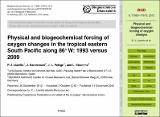Por favor, use este identificador para citar o enlazar a este item:
http://hdl.handle.net/10261/91681COMPARTIR / EXPORTAR:
 SHARE SHARE
 CORE
BASE CORE
BASE
|
|
| Visualizar otros formatos: MARC | Dublin Core | RDF | ORE | MODS | METS | DIDL | DATACITE | |

| Título: | Physical and biogeochemical forcing of oxygen changes in the tropical eastern South Pacific along 86º W: 1993 versus 2009 |
Autor: | Llanillo, P. J. CSIC ORCID; Karstensen, Johannes; Pelegrí, Josep Lluís CSIC ORCID ; Stramma, L. | Fecha de publicación: | dic-2012 | Editor: | European Geosciences Union | Citación: | Biogeosciences Discussions 9: 17583-17618 (2012) | Resumen: | Temporal changes of the water mass distribution and biogeochemical cycling in the tropical eastern South Pacific are investigated based on the extended Optimum Multi-Parameter (OMP) method. Two ship occupations of a meridional section along 85°50´ W, from 14° S to 1° N, are analysed, one during a relatively warm (El Niño/El Viejo, March 1993) and the other during a cold (La Niña/La Vieja, February 2009) upper-ocean phase. The largest El Niño - Southern Oscillation (ENSO) impact was found in the water properties and water mass distribution in the upper 250 m. The most prominent change is the vertical motion of the Oxygen Minimum Zone (OMZ) associated to the hypoxic Equatorial Subsurface Water (ESSW). During a cold phase the core of the ESSW is found at shallower layers, replacing the shallow (top 250 m) Subtropical Surface Water (STW) and allowing an intrusion of oxygen-rich and nutrient-poor Antarctic Intermediate Water (AAIW) in the depth range of 300 to 600 m. The shift in the vertical location of the intrusion of AAIW in the OMZ induces changes in oxygen advection and respiration, the largest the oxygen supply the greatest the respiration and the lowest the nitrate loss by denitrification. Changes in the intensity of the zonal currents in the Equatorial Current System, that ventilate the OMZ from the west, are used to explain the patchy latitudinal changes of seawater properties observed along the repeated section. Given that changes down to 800 m depth are observed, not only interannual (ENSO) but also decadal variability (Pacific Decadal Oscillation) is a potential driver for the observed changes | Descripción: | 36 pages, 9 figures, 1 table | Versión del editor: | https://doi.org/10.5194/bgd-9-17583-2012 | URI: | http://hdl.handle.net/10261/91681 | DOI: | 10.5194/bgd-9-17583-2012 | Identificadores: | doi: 10.5194/bgd-9-17583-2012 issn: 1810-6277 e-issn: 1810-6285 |
| Aparece en las colecciones: | (ICM) Artículos |
Ficheros en este ítem:
| Fichero | Descripción | Tamaño | Formato | |
|---|---|---|---|---|
| Llanillo_et_al_2012.pdf | 9,47 MB | Adobe PDF |  Visualizar/Abrir |
CORE Recommender
Page view(s)
311
checked on 23-abr-2024
Download(s)
236
checked on 23-abr-2024
Google ScholarTM
Check
Altmetric
Altmetric
NOTA: Los ítems de Digital.CSIC están protegidos por copyright, con todos los derechos reservados, a menos que se indique lo contrario.
